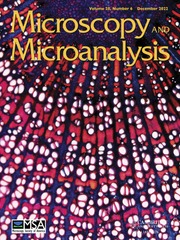No CrossRef data available.
Article contents
X-Ray Mapping with Energy-Dispersive and Wavelength-Dispersive X-Ray Spectrometry in the Scanning Electron Microscope: a Tutorial
Published online by Cambridge University Press: 02 July 2020
Extract
X-ray mapping is one of the most popular modes for displaying information obtained with x-ray spectrometry performed in the scanning electron microscope. This popularity arises from the ready accessibility and apparent simplicity of information presented in a pictorial fashion, especially when used in conjunction with other SEM imaging modes, such as backscattered, secondary, and specimen current electron images. Further, the rise of powerful, inexpensive computer systems capable of image processing and display has given the analyst a dedicated, on-line tool with the capacity and flexibility needed for problem solving. Figure 1 shows a typical example of mapping. Although the interpretation of x-ray images obtained with a modern digital control and recording system would seem to be straightforward and relatively trivial, there are significant pitfalls and limitations that can easily fool the unwary. In Figure 1, within an individual x-ray map, the observer can reasonably judge where the concentration is lower or higher, at least for a group of contiguous pixels. Can such judgments be made among a set of maps of the same region for different elements, or even for the same element from different regions of the same specimen? With current x-ray processing and display systems, the answers are generally no. In fact, problems that can influence interpretation can arise at each stage of x-ray generation/emission, x-ray spectral collection, processing, and display.
- Type
- EDS Mapping, the Right Way and the Wrong Way
- Information
- Copyright
- Copyright © Microscopy Society of America


